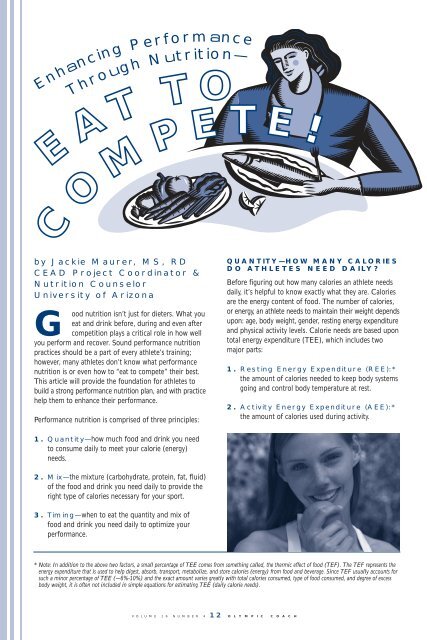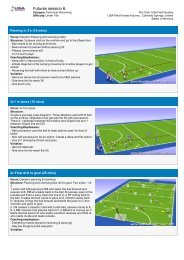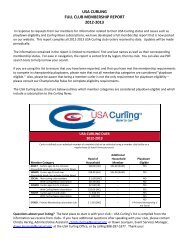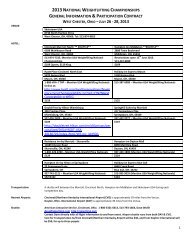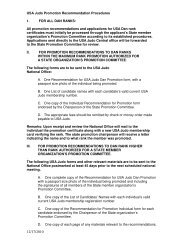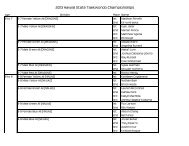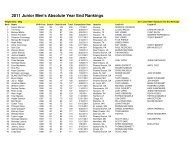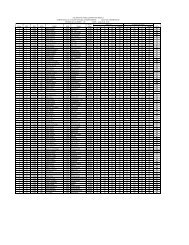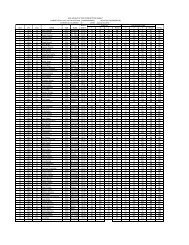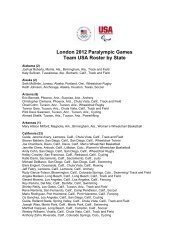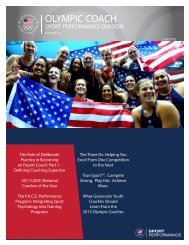OLYMPIC COACH - United States Olympic Committee
OLYMPIC COACH - United States Olympic Committee
OLYMPIC COACH - United States Olympic Committee
You also want an ePaper? Increase the reach of your titles
YUMPU automatically turns print PDFs into web optimized ePapers that Google loves.
Enhancing Performance<br />
Through Nutrition—<br />
EAT TO<br />
COMPETE!<br />
by Jackie Maurer, MS, RD<br />
CEAD Project Coordinator &<br />
Nutrition Counselor<br />
University of Arizona<br />
Good nutrition isn’t just for dieters. What you<br />
eat and drink before, during and even after<br />
competition plays a critical role in how well<br />
you perform and recover. Sound performance nutrition<br />
practices should be a part of every athlete’s training;<br />
however, many athletes don’t know what performance<br />
nutrition is or even how to “eat to compete” their best.<br />
This article will provide the foundation for athletes to<br />
build a strong performance nutrition plan, and with practice<br />
help them to enhance their performance.<br />
Performance nutrition is comprised of three principles:<br />
1. Quantity—how much food and drink you need<br />
to consume daily to meet your calorie (energy)<br />
needs.<br />
2. Mix—the mixture (carbohydrate, protein, fat, fluid)<br />
of the food and drink you need daily to provide the<br />
right type of calories necessary for your sport.<br />
3. Timing—when to eat the quantity and mix of<br />
food and drink you need daily to optimize your<br />
performance.<br />
VOLUME 16 NUMBER 4 12 O L Y M P I C C O A C H<br />
QUANTITY—HOW MANY CALORIES<br />
DO ATHLETES NEED DAILY?<br />
Before figuring out how many calories an athlete needs<br />
daily, it’s helpful to know exactly what they are. Calories<br />
are the energy content of food. The number of calories,<br />
or energy, an athlete needs to maintain their weight depends<br />
upon: age, body weight, gender, resting energy expenditure<br />
and physical activity levels. Calorie needs are based upon<br />
total energy expenditure (TEE), which includes two<br />
major parts:<br />
1. Resting Energy Expenditure (REE):*<br />
the amount of calories needed to keep body systems<br />
going and control body temperature at rest.<br />
2. Activity Energy Expenditure (AEE):*<br />
the amount of calories used during activity.<br />
* Note: In addition to the above two factors, a small percentage of TEE comes from something called, the thermic effect of food (TEF). The TEF represents the<br />
energy expenditure that is used to help digest, absorb, transport, metabolize, and store calories (energy) from food and beverage. Since TEF usually accounts for<br />
such a minor percentage of TEE (~6%-10%) and the exact amount varies greatly with total calories consumed, type of food consumed, and degree of excess<br />
body weight, it is often not included in simple equations for estimating TEE (daily calorie needs).


